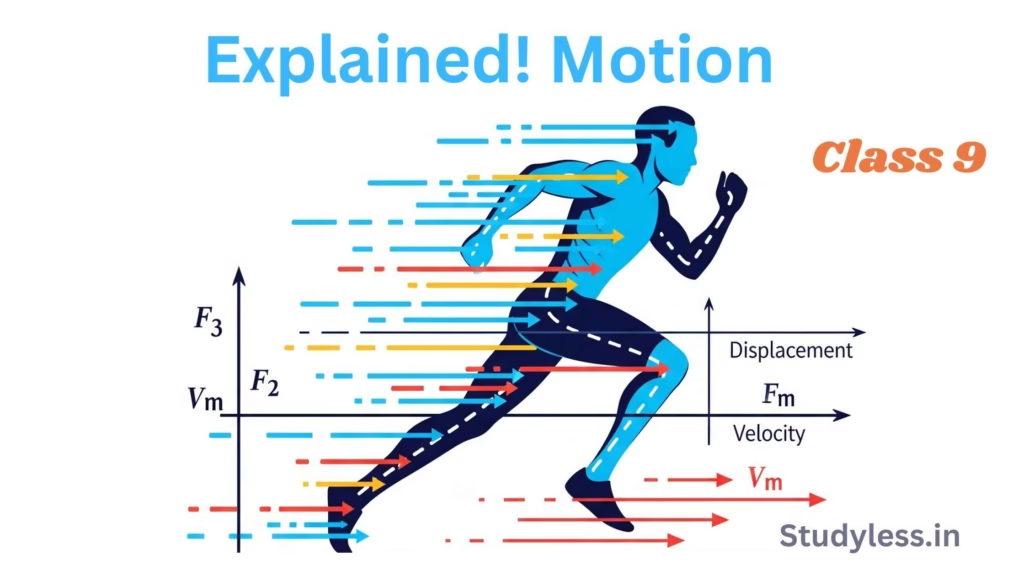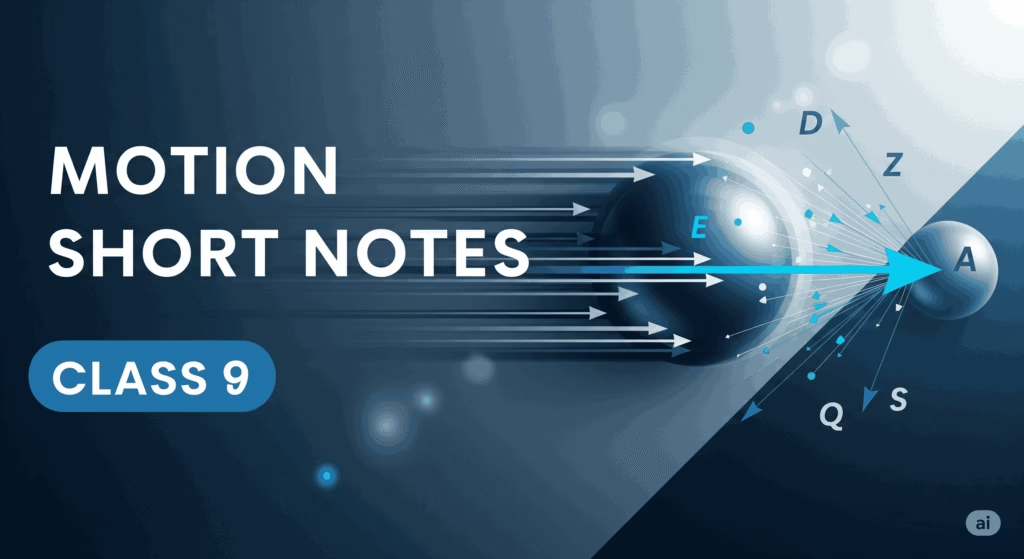Think you’ve mastered Motion? 💭 Our foundational sets helped you build skills—now ignite your genius with the ultimate challenge:
🚀 [2025] Motion Topic-Wise TOUGH Questions for Hungry Minds! DARE TO SOLVE ALL! 🚀
| For Students Who: | Why This Set Crushes Limits | ⚡️ |
|---|---|---|
| 🧠 Crave Depth | Shatters surface-level understanding | ✅ |
| 🏆 Chase Excellence | Preps you for elite exams (JEE/NEET/Olympiads) | ✅ |
| 💥 Thrive on Challenge | Curated 2025-level twists to break mental barriers | ✅ |
“Where others stop—your brilliance begins. Prove you belong in the top 1%. 🔥”

Table of Contents
Topic 1: Introduction to Motion and Reference Point
Question: How can the motion of air be inferred, given that it is not directly perceived by a change in its position?
Explanation:
The motion of air, which is not directly perceived by a change in its position, can be inferred through indirect evidence.
For instance, we infer the motion of air by observing the movement of dust and the movement of leaves and branches of trees.
This highlights that motion can be understood even when direct observation of an object’s changing position is not possible, by observing its effects on other objects.
Question: Explain how the perception of an object’s motion can be relative, providing examples from the source.
Explanation:
The perception of an object’s motion is relative because an object may appear to be moving for one person and stationary for another.
For example, for passengers inside a moving bus, their fellow passengers appear to be at rest, while a person standing on the roadside perceives the bus, along with its passengers, as moving.
Conversely,
the roadside trees appear to be moving backwards for the passengers in a moving bus. These observations indicate that the description of motion is dependent on the observer’s frame of reference.
Question: Why is a reference point, also called the origin, essential for describing the location and position of an object?
Explanation:
To describe the location or position of an object, it is necessary to specify a reference point, which is called the origin.
The source illustrates this with an example: a school’s position is specified as 2 km north of a railway station. In this scenario, the railway station serves as the reference point.
Without a defined reference point, the description of an object’s position would be ambiguous, as position is always relative to a chosen point.
Topic 2: Distance and Displacement
Question: Describe the fundamental difference between ‘distance’ and ‘displacement’ using an example from the source to illustrate when their magnitudes may differ.
Explanation:
Distance refers to the total path length covered by an object, and it only requires its numerical value (magnitude) to be described.
On the other hand, displacement is the shortest distance measured from the initial to the final position of an object. The magnitudes of distance and displacement can differ.
For example,
if an object moves from point O to A (60 km) and then back to B (which is 35 km from O), the total distance covered is 60 km + 25 km = 85 km (where 25 km is the distance from A to B). However, the magnitude of the displacement is only 35 km, which is the shortest distance directly from O to B.
Question: Under what specific condition can the magnitude of the displacement of an object be equal to the distance traveled? Provide an example.
Explanation:
The magnitude of the displacement of an object can be equal to the distance traveled when the object moves along a straight line and does not change its direction.
For instance, if an object moves directly from O to A, the distance covered is 60 km, and the magnitude of the displacement is also 60 km.
In this particular case, the total path length and the shortest path between the initial and final positions are identical.
Question: Is it possible for an object to have zero displacement but a non-zero distance covered? If yes, provide a scenario supported by the source.
Explanation:
Yes, it is possible for an object to have zero displacement while still covering a non-zero distance. This occurs when the object’s final position coincides with its initial position.
For example,
if an object travels from O to A (60 km) and then returns back to its initial position O (another 60 km), its displacement is zero because it ended up where it started. However, the total distance covered in this journey is OA + AO = 60 km + 60 km = 120 km.
Topic 3: Uniform and Non-Uniform Motion
Question: Distinguish between uniform and non-uniform motion based on how distances are covered over equal time intervals.
Explanation:
In uniform motion, an object covers equal distances in equal intervals of time.
This means its speed is constant. An example given is an object covering 5 m in each consecutive second.
In contrast, non-uniform motion describes situations where objects cover unequal distances in equal intervals of time.
Everyday examples include a car moving on a crowded street or a person jogging in a park, where their speed, and thus the distance covered per unit time, often varies.
Question: Using the data from Table 7.1, determine if Object A and Object B exhibit uniform or non-uniform motion. Justify your answer for each.
Explanation:
- Object A: Exhibits uniform motion. According to Table 7.1, Object A consistently travels 10 m every 15 minutes (e.g., from 9:30 am to 9:45 am, it moves from 10 m to 20 m, a difference of 10 m; from 9:45 am to 10:00 am, it moves from 20 m to 30 m, also a 10 m difference, and so on). Since it covers equal distances in equal time intervals, its motion is uniform.
- Object B: Exhibits non-uniform motion. As shown in Table 7.1, Object B covers varying distances in the same 15-minute intervals (e.g., 7 m, 4 m, 12 m, 2 m, 4 m, 3 m). Because it covers unequal distances in equal intervals of time, its motion is non-uniform.
Topic 4: Speed and Velocity
Question: What is the key distinction between speed and velocity? How does this distinction affect their description and measurement?
Explanation:
The key distinction between speed and velocity lies in the inclusion of direction. Speed is a scalar quantity that requires only its numerical value (magnitude) for its specification, representing the distance traveled per unit time.
Its SI unit is meters per second (m s⁻¹). Velocity, however, is a vector quantity that specifies both the speed and the direction of motion of an object.
While both share the same SI unit (m s⁻¹), velocity provides a more comprehensive description of an object’s rate of motion by incorporating direction, making it possible for velocity to change even if speed remains constant (e.g., in circular motion).
Question: Under what condition(s) is the magnitude of the average velocity of an object equal to its average speed?
Explanation:
The magnitude of the average velocity of an object is equal to its average speed when the object moves along a straight line without changing its direction.
In such a scenario, the total distance traveled is precisely equal to the magnitude of the displacement. Since both average speed (Total distance travelled / Total time taken) and average velocity (Displacement / Total time taken) are calculated over the same total time, their magnitudes will be identical under this specific condition.
If the object changes direction, its displacement will be less than the distance, causing the average velocity magnitude to be less than the average speed.
Question: A car travels 100 km in 2 hours. Is it guaranteed that the car maintained a constant speed of 50 km/h throughout the journey? Explain why or why not, referring to the concept of average speed.
Explanation:
No, it is not guaranteed that the car maintained a constant speed of 50 km/h throughout the journey. The value of 50 km h⁻¹ represents the car’s average speed, which is calculated by dividing the total distance (100 km) by the total time taken (2 h).
The source explicitly states that “The car might not have travelled at 50 km h⁻¹ all the time. Sometimes it might have travelled faster and sometimes slower than this”.
This is common in real-world scenarios where objects often exhibit non-uniform motion, meaning their instantaneous speed varies over time.
Question: Usha swims 180 m in a 90 m long pool, swimming from one end to the other and back along the same straight path in one minute. Calculate her average speed and average velocity, and explain the difference in these two values.
Explanation:
- Total distance covered by Usha: 180 m.
- Total time taken: 1 minute = 60 seconds.
- Average speed: Calculated as Total distance covered / Total time taken. Average speed = 180 m / 60 s = 3 m s⁻¹.
- Displacement of Usha: Since Usha swims from one end to the other and then back along the same straight path, her final position is identical to her initial position. Therefore, her displacement is 0 m.
- Average velocity: Calculated as Displacement / Total time taken. Average velocity = 0 m / 60 s = 0 m s⁻¹.
- The difference between the average speed (3 m s⁻¹) and average velocity (0 m s⁻¹) arises because average speed considers the total path length traveled, while average velocity considers only the net change in position (displacement) relative to the starting point.
Topic 5: Acceleration
Question: Define acceleration. How does its sign (positive or negative) relate to the direction of velocity?
Explanation:
Acceleration is a physical quantity that measures the change in the velocity of an object per unit time. It is calculated using the formula: acceleration (a) = (final velocity (v) – initial velocity (u)) / time taken (t). The SI unit of acceleration is m s⁻². The sign of acceleration indicates its direction relative to the velocity:
- Acceleration is taken to be positive if it is in the same direction as the velocity. This means the object is speeding up.
- Acceleration is taken to be negative when it is opposite to the direction of velocity. This implies the object is slowing down (decelerating).
Question: What differentiates uniform acceleration from non-uniform acceleration? Provide an example of uniform acceleration.
Explanation:
An object is said to have uniform acceleration if it travels in a straight line and its velocity increases or decreases by equal amounts in equal intervals of time.
An example of uniformly accelerated motion is the motion of a freely falling body, where velocity changes at a constant rate due to gravity.
Conversely, an object travels with non-uniform acceleration if its velocity changes at a non-uniform rate.
For example,
a car accelerating on a straight road by increasing its speed by unequal amounts in equal intervals of time would exhibit non-uniform acceleration.
Question: A bus decreases its speed from 80 km h⁻¹ to 60 km h⁻¹ in 5 seconds. Calculate the acceleration of the bus.
Explanation:
- Initial velocity (u) = 80 km h⁻¹. To convert to m s⁻¹, use 1 km = 1000 m and 1 h = 3600 s: u = 80 × (1000/3600) m s⁻¹ ≈ 22.22 m s⁻¹.
- Final velocity (v) = 60 km h⁻¹. Converting to m s⁻¹: v = 60 × (1000/3600) m s⁻¹ ≈ 16.67 m s⁻¹.
- Time (t) = 5 s. Using the acceleration formula, a = (v – u) / t: a = (16.67 m s⁻¹ – 22.22 m s⁻¹) / 5 s a = -5.55 m s⁻¹ / 5 s a = -1.11 m s⁻² (approximately). The negative sign indicates that the bus is decelerating, meaning the acceleration is in the opposite direction to its motion.
Topic 6: Graphical Representation of Motion
Question: How does a distance-time graph represent uniform speed, and what mathematical property of the graph can be used to determine the object’s speed?
Explanation:
When an object travels at a uniform speed, its distance-time graph is a straight line. This is because the distance traveled is directly proportional to the time taken, reflecting the covering of equal distances in equal time intervals.
The portion OB in Fig. 7.3 exemplifies this uniform rate of distance increase. The speed (v) of the object can be determined from the slope (or gradient) of this straight line on the distance-time graph.
By selecting two points (t₁, s₁) and (t₂, s₂) on the graph, the speed is calculated as v = (s₂ – s₁) / (t₂ – t₁), which represents the change in distance over the change in time.
Question: What does the shape of a distance-time graph indicate if an object is moving with non-uniform speed? Refer to the provided figures.
Explanation:
If an object is moving with non-uniform speed, its distance-time graph will show a non-linear variation of the distance traveled with time.
This means the graph will not be a straight line but rather a curve.
Figure 7.4 in the Your NCERT textbook chapter 7 motion clearly illustrates this, depicting a curved distance-time graph for a car moving with non-uniform speed, signifying that the car covers unequal distances in equal intervals of time.
Question: Describe the appearance of a velocity-time graph for an object undergoing uniform motion. How can the displacement of the object be determined from this graph?
Explanation:
For an object undergoing uniform motion (meaning uniform velocity), its velocity-time graph will be a straight line parallel to the x-axis (time axis).
This indicates that the velocity remains constant and does not change over time. Figure 7.5 illustrates this, showing a car maintaining a uniform velocity of 40 km h⁻¹. T
he magnitude of the displacement of the object can be determined by calculating the area enclosed by the velocity-time graph and the time axis.
For uniform velocity,
this area typically forms a rectangle. For instance, the distance (s) covered by the car between time t₁ and t₂ in Fig. 7.5 is given by the area of the rectangle ABDC, calculated as velocity × (t₂ – t₁).
Question: How does a velocity-time graph for uniformly accelerated motion differ from that of uniform motion? What information can be derived from the area under a uniformly accelerated motion velocity-time graph?
Explanation:
For uniformly accelerated motion, the velocity-time graph is a straight line with a non-zero slope. This straight line indicates that the velocity changes by equal amounts in equal intervals of time.
This is distinct from uniform motion, where the velocity-time graph is a straight line parallel to the time axis (zero slope).
Figure 7.6 in your NCERT textbook chapter 7 motion shows an example of a velocity-time graph for a car moving with uniform acceleration.
The distance (magnitude of displacement) moved by the object during a given time interval can be determined by calculating the area under the velocity-time graph.
For uniformly accelerated motion, this area typically takes the shape of a trapezoid or can be broken down into the sum of the areas of a rectangle and a triangle (e.g., area ABCDE in Fig. 7.6).
Question: What does the velocity-time graph look like for an object in non-uniformly accelerated motion? Provide examples of such graphs.
Explanation: In the case of non-uniformly accelerated motion, velocity-time graphs can have any shape. This is because the object’s velocity changes at an inconsistent or non-uniform rate, meaning it does not increase or decrease by equal amounts in equal intervals of time. Figure 7.7 provides examples of such graphs:
- Figure 7.7(a) shows a velocity-time graph where the object’s velocity is decreasing with time in a non-linear, curving fashion.
- Figure 7.7(b) depicts a velocity-time graph that represents a more general non-uniform variation of velocity with time, showing an erratic or irregular change. These non-linear shapes are characteristic of non-uniform acceleration, distinguishing them from the straight lines of uniform acceleration.
Topic 7: Equations of Motion
Question: List the three equations of motion for an object moving with uniform acceleration and specify what physical quantities each equation relates.
Explanation:
For an object moving along a straight line with uniform acceleration, a set of three equations known as the equations of motion relate its velocity, acceleration, distance covered, and time.
These equations are:
- v = u + at This equation describes the velocity-time relation, connecting the final velocity (v), initial velocity (u), uniform acceleration (a), and time (t).
- s = ut + ½ at² : This equation represents the position-time relation, linking the distance traveled (s), initial velocity (u), time (t), and uniform acceleration (a).
- 2as = v² – u² : This equation establishes the relation between position and velocity, relating uniform acceleration (a), distance traveled (s), final velocity (v), and initial velocity (u). This third equation can be obtained by eliminating time (t) from the first two equations.
Question: A racing car has a uniform acceleration of 4 m s⁻². Calculate the distance it will cover in 10 s after starting from rest.
Explanation:
- Initial velocity (u) = 0 m s⁻¹ (since it starts from rest).
- Uniform acceleration (a) = 4 m s⁻².
- Time (t) = 10 s. To calculate the distance covered (s), we can use the second equation of motion: s = ut + ½ at². Substituting the given values into the equation: s = (0 m s⁻¹) × (10 s) + ½ × (4 m s⁻²) × (10 s)² s = 0 + ½ × 4 m s⁻² × 100 s² s = 2 m s⁻² × 100 s² s = 200 m. Therefore, the racing car will cover a distance of 200 m in 10 seconds.
Topic 8: Uniform Circular Motion
Question: Explain why an object moving in a circular path with uniform speed is considered to be undergoing accelerated motion.
Explanation:
An object moving in a circular path at a constant speed is indeed considered to be undergoing accelerated motion. This is because velocity is defined as speed with direction.
Even if the magnitude of the velocity (speed) remains constant, the direction of the object’s motion is continuously changing at every point along the circular path.
Since acceleration is defined as the change in velocity per unit time, and a change in direction constitutes a change in velocity, the object is continuously accelerating towards the center of the circle.
Question: What is uniform circular motion, and provide three examples of objects exhibiting this type of motion as mentioned in the source.
Explanation:
Uniform circular motion occurs when an object moves in a circular path with uniform speed. Despite the constant speed, it is a type of accelerated motion because the direction of velocity continuously changes.
The Motion chapter 7 of your NCERT textbook provides several familiar examples of objects moving under uniform circular motion:
- The motion of the moon around the earth.
- A satellite in a circular orbit around the earth.
- A cyclist on a circular track at constant speed.
Question: If an object is moving in a circular path and is suddenly released, in what direction will it move? What does this demonstrate about its motion on the circular path?
Explanation:
If an object moving in a circular path is suddenly released, it will move along a straight line tangential to the circular path at the point of release.
This is illustrated by the activity of swinging a stone tied to a thread in a circle and then releasing it. This phenomenon demonstrates that at every instant during its circular motion, the object’s direction of motion is tangential to the circle.
When released,
the object continues to move in the specific direction it possessed at that precise moment, thereby showcasing the continuous change in direction that defines circular motion.
Conclusion : Motion topic wise Tough Questions
I could thought of only this muc questions!
If you wnat to share some questions tehn please comment below.





![[2025] Unlock What is Democracy Why Democracy | Class 9 Political Science Chapter 1 Explained! Don’t Miss](https://studyless.in/wp-content/uploads/2025/05/What-is-Democracy-Why-Democracy_11zon-1024x579.avif)
Leave a Comment